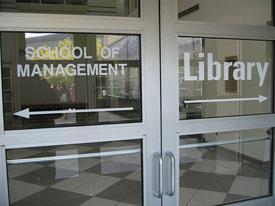
Image adapted from williamhartz under a Creative Commons license: BY-NC-SA.
This course is no longer taught at the U-M School of Information. These materials are from an older iteration of the course.
Information practice demands knowledge of all aspects of management and service delivery. This course introduces selected theories, principles and techniques of contemporary management science, and organizational behavior and their application to libraries and information services. Students develop skills in planning, organizing, personnel management, financial management, leading, marketing, stakeholder management, and coordinating functions in libraries and information services. Students also have the opportunity to think critically about, and reflect upon, contemporary management practice in information organizations.
Information professionals find that no matter whether they choose a career as a single entrepreneur, solo librarian, archivist, or whether they join a large organization, they become managers -- of themselves, of clients or staff, and sometimes of substantial systems and services.
Instructor: Tiffany Veinot
dScribe: Jen Bonnet
Course Level: Graduate
Course Structure: 3 hour lecture, once a week
Syllabus
COURSE OVERVIEW
Information practice demands knowledge of all aspects of management and service delivery. This course introduces selected theories, principles and techniques of contemporary management science and organizational behaviour and their application to libraries and information services. Students develop skills in the planning, organizing, personnel and financial management, leading, marketing, stakeholder management and coordinating functions in libraries and information services. Students will also have the opportunity to think critically about, and reflect upon, contemporary management practice in information organizations. Through classroom instruction, workshops on specific management skills, assignments, readings, discussion and guest lecturers, this course will help to prepare students to assume managerial responsibilities in their work.
LEARNING OBJECTIVES
1. To develop an understanding of theories, principles and techniques of contemporary management science and organizational behavior and their application to libraries and information services.
2. To develop skills in the planning, organizing, personnel and financial management, leading, marketing, stakeholder management and coordinating functions in libraries and information services.
3. To promote critical thinking and reflexivity about professional practice as managers of libraries and information services.
COURSE RESOURCES
There is a text book for this course, which is available for purchase at the Campus Bookstore:
Stueart, R. & Moran, B. (2007). Library and Information Center Management. 7th Edition. Westport, Connecticut: Libraries Unlimited.
In addition to the course text, there are assigned readings drawn from a range of sources. Course readings and other resources are delivered via the University of Michigan CTools course management system (or in a few cases, the World Wide Web). The Resources folder in CTools contains copies of the weekly course readings, located in subfolders labelled by week number.
Separate CTools folders include tools for submitting assignments, a discussion board and other facilities. The most current copy of this document, the Course Syllabus, also resides on the CTools site. CTools maintains an archive of all email messages sent to the entire class.
All course materials are provided in electronic form under the "fair use" copyright exemption. This means that you may not redistribute copies of class readings outside the class. For more information see "Copyright at the University of Michigan: For Students."
OVERVIEW OF ASSIGNMENTS
Participation
Due: Various Classes
Percent of Final Grade: 10%
Planning Case Study
Due: Class 3
Percent of Final Grade: 20%
Organizational Design Case Study
Due: Class 5
Percent of Final Grade: 20%
Human Resources Case Study
Due: Class 8
Percent of Final Grade: 25%
Budget Case Study
Due: Class 12
Percent of Final Grade: 25%
Written Assignments
Assignments should be written in a 12 point font on letter-sized paper with one inch margins. All papers should be double-spaced. Please use American Psychological Association (APA) style guidelines for citing materials used in your assignments. The style guide can be found online at: http://owl.english.purdue.edu/owl/resource/560/01/.
Assignments
1) Planning Case Study – 20%
Purpose:
- To develop an understanding of theories, principles and techniques of contemporary management science and organizational behavior and their application to libraries and information services.
- To develop skills in the planning function in libraries and information services.
Procedure:
Scenario
You are the new director of a small, liberal arts college library with 100 faculty members and approximately 1,300 students. Your library focuses on serving undergraduate students through a collection stored in one library building and through digital services. Your library staff includes five information professionals (one of whom is also your Associate Director), a line manager and five full-time support staff members, a part-time support staff member and a number of part-time, seasonal student assistants. You report directly to an associate provost.
Your staff members complain that they feel like they are in constant organizational crisis, overwhelmed with work and exhausted from trying to do everything all at once. Some staff members also complain that they don’t know what the priorities are for their work. You think that an important reason for these problems is that your library has no formal plan, either strategic or operational. This is despite the fact that the college in which your library operates has a strategic plan. To address these problems, you want to embark on a planning exercise within your library.
Analysis
Write a short paper (4-5 pages, plus references) in which you outline and justify how you will manage a planning process in your library. What kind of planning will you engage in? Who will be involved in the planning, and in what roles? What activities will you undertake as a part of your planning process? What document(s) would emerge from the planning process, and what major sections would they contain? What would be the next steps in implementing the plan(s)? Briefly justify each of your major decisions with reference to the planning course readings.
2) Organizational Design Case Study – 20%
Purpose:
- To develop an understanding of theories, principles and techniques of contemporary management science and organizational behavior and their application to libraries and information services.
- To develop skills in the organizing function in libraries and information services.
Procedure:
Scenario
You are information professional who is responsible for recommending an organizational design for a public library with a main branch and two branch libraries. The suburban library serves an economically and racially diverse population of 75,000 in a community close to a large metropolitan area. The library has 64 staff members (FTE), with 16 librarians and 48 other staff members. The library’s annual budget is $4.5 million. The library collection contains approximately 500,000 volumes, 900 subscriptions and 20,000 audiovisual items. The library had a circulation of approximately 900,000 items in the past year, responded to 150,000 reference questions, provided 3,000 interlibrary loans and offered well-attended children, teen and adult programs. For example, the library offers book clubs for adults, reader’s advisory services, storytime for preschoolers and gaming events for teens. The library also offers free Internet access through 35 public terminals, Internet training classes and free space to use for meetings and events. One the web, the library offers services such as an online catalogue, access to digital magazine and newspaper collections, automated renewal and Internet research guides.
Analysis Write a short paper (4-5 pages, double-spaced, plus references) in which you draw, describe and justify an organizational chart for this library. In order to do this, your paper should identify the main products/services of the library, how production of these products/services is organized and the tasks involved in each the production of each product/service. Please state clearly any assumptions which you have made in order to develop this organizational chart.
Based on this background analysis, draw and describe an organizational chart that shows the staff units and number of people involved in each unit, lines of authority and levels of management. Justify your major decisions in terms of organizational design principles described in the course readings, including: vertical and horizontal specialization, centralization/decentralization, unity of command, span of control, coordinating mechanisms and organizational flexibility.
3) Human Resources Case Study– 25%
Purpose:
- To develop an understanding of theories, principles and techniques of contemporary management science and organizational behavior and their application to libraries and information services.
- To develop skills in the human resources function in libraries and information services.
Procedure:
Scenario
You are a manager at the Kresge Business Administration Library at the University of Michigan, an independent library which serves The Ross Business School, which has approximately 800 full-time students. You just received budget approval to hire a new, entry-level public services librarian so as to expand library services. Review this library’s Web site, and that of its parent institution in order to become familiar with its services and institutional environment. To complete this assignment, you do not need to contact this library’s staff to find out any more about the library than that which is publicly stated on these sites.
Analysis
Write a short paper (6-8 pages, double-spaced, plus references) in which you describe the processes that you will follow in order to hire for this position. In particular, your paper should address the following issues:
- Based on your reading of the library and business school Web site, what 4-5 major duties are likely to be a part of this position? (You may need to make some assumptions about the library’s services and future plans. Please state any assumptions in your paper).
- Based on its major duties, what core competencies will be required for this position?
- Develop a draft job posting that will detail the primary duties for the position, and its required qualifications.
- How will you identify the applicants to interview for this position? Justify your proposed process with reference to the course readings.
- Develop a set of ten questions for the interview indicating what skills, abilities and characteristics will be demonstrated through responses to each question.
- When the new person starts work, what plans will you have to integrate them into the new position and the library? Justify your plans with reference to the course readings.
4) Budget Case Study – 25%
Purpose:
- To develop an understanding of theories, principles and techniques of contemporary management science and organizational behavior and their application to libraries and information services.
- To develop skills in the financial management functions in libraries and information services.
Procedure:
Form a work group with your classmates – each group should have 4-5 participants. Please notify our GSI, Max Chen, of the composition of your group by Class 6. As a group, choose one of the following library budget case studies on the course text Web site:
- Budget for a new library – The School of Filmmaking Library—UNC-DC
- Cost cutting budget – The KelTel Corporation or The Leafyview Public Library (note: do not complete the oral presentation at the end of this case; only the written portion is required)
- Collection donation and library expansion budget - Gloucester Historical Society Library and Archives
Review the case scenario and complete the instructions for the written portion of the assignment as outlined on the case study web page. One budget assignment will be submitted per group, and a single grade will be assigned to each member of the group.
Schedule
Class 1 – An Introduction to Management
We examine the role of managers and the work that managers do. We also survey some of the key classical and contemporary theories of management practice.
READINGS
Required
Stueart, R. D., & Moran, B. B. (2007). Chapter 1: Managing in Today's Libraries and Information Centers. In Library and Information Center Management (7th ed., pp. 3-15). Westport, CT: Libraries Unlimited.
Stueart, R. D., & Moran, B. B. (2007). Chapter 2: The Evolution of Management Thought. In Library and Information Center Management (7th ed., pp. 19-40). Westport, CT: Libraries Unlimited.
Recommended
Mintzberg, H. (1975). The Manager's Job: Folklore and Fact. Harvard Business Review, 53(4), 49-61.
Class 2 – Planning in Libraries and Information Services
We discuss the importance of planning in libraries and information services, and examine approaches to short-term and long-term planning. In particular, we explore the processes of strategic, scenario and operational planning.
READINGS
Required
Hannabuss, S. (2001). Scenario Planning for Libraries. Library Management, 22(4/5), 168-176.
Stueart, R. D., & Moran, B. B. (2007). Chapter 4: Planning Information Systems and Services. In Library and Information Center Management (7th ed., pp. 65-92). Westport, CT: Libraries Unlimited.
Stueart, R. D., & Moran, B. B. (2007). Chapter 5: Strategic Planning - Thinking and Doing. In Library and Information Center Management (7th ed., pp. 93-117). Westport, CT: Libraries Unlimited.
Recommended
Library strategic plan examples – http://lu.com/management/examples.cfm [skim]
Matthews, J. R. (2005). Strategic planning and management for library managers. Westport,
CT: Libraries Unlimited. (pp. 1-28)
Pacios, A. R. (2004). Strategic Plans and Long-Range Plans: Is There a Difference? Library Management, 25(6/7), 259-269.
Class 3 – Organizational Design (Max Chen)
This week, we examine the nature of libraries as organizations and the different ways of structuring work in libraries. We assess different organizational designs with respect to their strengths and weaknesses, as well as the principles of specialization and coordination. We also specifically examine ways to encourage organizational learning through organizational design choices.
Planning Case Study Due (20%) – 5 pm sharp
READINGS
Required
Stueart, R. D., & Moran, B. B. (2007). Chapter 7: Organizations and Organizational Culture. In Library and Information Center Management (7th ed., pp. 131-147 only). Westport, CT: Libraries Unlimited.
Stueart, R. D., & Moran, B. B. (2007). Chapter 8: Structuring the Organization – Specialization and Coordination. InLibrary and Information Center Management (7th ed., pp. 156-180). Westport, CT: Libraries Unlimited.
Stueart, R. D., & Moran, B. B. (2007). Chapter 9: The Structure of Organizations – Today and in the Future. InLibrary and Information Center Management (7th ed., pp. 181-204). Westport, CT: Libraries Unlimited.
Recommended
Brenfeld, B. A. (2004). Developing a team management structure in a public library. Library Trends, 53(1), 112-128.
James, C. R. (2003). Designing Learning Organizations. Organizational Dynamics, 32(1), 46-61.
Leavitt, H. J. (2003). Why Hierarchies Thrive. Harvard Business Review, 81(3), 96-102.
Library organization chart examples – http://lu.com/management/examples.cfm [skim]
Class 4 – Stakeholder Management, Collaboration and Partnerships
This week, we examine strategies for identifying and managing stakeholders with an interest in the library/information service and the power to influence it. We also explore the rationale for library participation in inter-organizational collaborations, and approaches to developing and managing collaborative initiatives.
Guest Speaker: Ellen Stross, Adult Services Librarian, Plymouth District Library
READINGS
Required
Bryson, J.M., Crosby, B.C. and Stone, M. M. The Design and implementation of cross-sector collaborations: Propositions from the literature. Public Administration Review, 66(s1), 44-55.
Crowther, J. H. and Trott, B. (2004). Partnering with purpose: a guide to strategic partnership development for libraries and other organizations (pp. 3-23). Westport, CT: Libraries Unlimited.
Kohl, D. and Sanville T. (2006) More bang for the buck: Increasing the effectiveness for library expenditures through cooperation. Library Trends, 54(3), 394-410.
Savage, G.T., Nix, T.W., Whitehead, C.J., Blair, J.D. (1991). Strategies for Assessing and Managing Organizational Stakeholders. Academy of Management Executive, 5(2), 61-75.
Recommended
Crowther, J. H., & Trott, B. (2004). Partnering with purpose: a guide to strategic partnership development for libraries and other organizations (pp. 57-66). Westport, CT: Libraries Unlimited.
Mitchell, R. K., B. R. Agle, and D.J. Wood. (1997). Toward a theory of stakeholder identification and salience: Defining the principle of who and what really counts. Academy of Management Review, 22(4), 853 - 888.
Class 5 – Human Resources Management I: Staffing and Hiring
This week, we examine approaches to hiring appropriate staff for libraries and information services, including development of job descriptions, job analysis/evaluation and approaches to recruitment and hiring. Additionally, we outline key legislative frameworks surrounding hiring.
Organizational Design Case Study (20%) – due at 5 pm sharp
READINGS
Required
Kaspar, W.A. and Mosley, P.A. (2008). Making the good hire: Updating hiring practices for the contemporary multigenerational workforce, part two. Library Administration & Management, 22(2), 92-99.
Stueart, R. D., & Moran, B. B. (2007). Chapter 10: Staffing the library. In Library and Information Center Management (7th ed., pp. 207-234). Westport, CT: Libraries Unlimited.
Stueart, R. D., & Moran, B. B. (2007). Chapter 12: Other issues in human resource management. In Library and Information Center Management (7th ed., pp. 280-295 only). Westport, CT: Libraries Unlimited.
Recommended
Hilyard, N.B. (2006). On recruitment. Public Libraries, 45(1): 14-23.
Library job description examples - http://lu.com/management/examples.cfm
Mosley, P.A. and Kaspar, W.A. (2008). Making the good hire: Updating hiring practices for the contemporary multigenerational workforce, part one. Library Administration & Management, 22(2), 92-99.
McKay, R. (2006). Inspired hiring: Tools for success in interviewing and hiring library staff. Library Administration & Management, 20 (3), 128-134.
Class 6 – Human Resources Management II: Training, Supervision and Performance Management
We examine the organizational human resources functions required for employees, including training, performance management and employee compensation. Additionally, we discuss important issues in supervision of individual employees, such as appropriate delegation, coaching, and enhancing employee motivation.
READINGS
Required
Lubans, Jr., J. (2006). Coaching for results. Library Administration & Management, 20(2), 86-89.
Stueart, R. D., & Moran, B. B. (2007). Chapter 11: The human resources functions in the library. In Library and Information Center Management (7th ed., pp. 235-266). Westport, CT: Libraries Unlimited.
Stueart, R. D., & Moran, B. B. (2007). Chapter 13: Motivation. In Library and Information Center Management (7th ed., pp. 299-320). Westport, CT: Libraries Unlimited.
Trotta, M. (2006). Supervising staff: a how-to-do-it manual for library applications (pp. 1-42). New York, NY: Neal-Schuman Publishers
Recommended
Grote, D. (2001). Discipline without punishment. Across the Board, 38(5), 52-57.
Library performance evaluation form examples - http://lu.com/management/examples.cfm
O'Connor, M. (2006). A Review of Factors Affecting Individual Performance in Team Environments: Theories and Implications for Library Management. Library Management, 27(3), 135-143.
Tucker, James Cory. (2004). Getting Down to Business: Library Staff Training. Reference Services Review 32(3): 293-301.
Class 7 – Communication and Team Work
This week, we consider communication as an essential responsibility for managers, and reflect upon strategies for engaging in effective communication in both the workplace in general and work groups in particular. As a special case, we also examine communication in situations of conflict. We also discuss participatory managerial practices that support the development and effective functioning of teams in libraries and information services.
READINGS
Required
Stueart, R. D., & Moran, B. B. (2007). Chapter 16: Communication. In Library and Information Center Management(7th ed., pp. 363-384). Westport, CT: Libraries Unlimited.
Stueart, R. D., & Moran, B. B. (2007). Chapter 17: Participative Management and the Use of Teams in Libraries. InLibrary and Information Center Management (7th ed., pp. 385-408). Westport, CT: Libraries Unlimited.
Tannen, Deborah. (1995). The Power of Talk: Who Gets Heard and Why. Harvard Business Review, 73(5), 138-148.
Wetlaufer, S. (1994). The team that wasn’t. Harvard Business Review, 72(6), 22-26.
Recommended
Ross, C. S. and Dewdney, P. (1998). Communicating professionally: A how-to-do-it manual for library applications. (2nd ed., pp. 3-72; 139-170) New York: Neal-Schuman.
Class 8 – Leadership and Organizational Change
We reflect on the nature of leadership, from the roles that leaders play in organizations, to the traits that leaders exhibit to the specific work of leadership. We also consider the status of leadership in the field of libraries and information services. In the context of leadership, we also consider models for decision making within organizations – particularly approaches to making challenging decisions in turbulent environments.
Human Resources Case Study (25%) – due at 5 pm sharp
READINGS
Required
Heifetz, R. A., & Laurie, D. L. (2001). The Work of Leadership. Harvard Business Review(December), 131-141.
Kotter, J. P. (1990). What Leaders Really Do. Harvard Business Review(May-June), 103-111.
Stueart, R. D., & Moran, B. B. (2007). Chapter 3: Change – The Innovation Process. In Library and Information Center Management (7th ed., pp. 41-61). Westport, CT: Libraries Unlimited.
Stueart, R. D., & Moran, B. B. (2007). Chapter 14: Leadership. In Library and Information Center Management (7th ed., pp. 321-345). Westport, CT: Libraries Unlimited.
Recommended
Kotter, John P. and Schlesinger, Leonard A. (2008). Choosing Strategies for Change. Harvard Business Review, 86(7/8), 131-139.
Riggs, D. E. (2001). The Crisis and Opportunities in Library Leadership. Journal of Library Administration, 32(3/4), 5-17.
Smith, I. (2006). Achieving Successful Organizational Change: Do’s and Don’ts of Change Management. Library Management, 27(4/5), 300-306.
Snowden, D. J., & Boone, M. E. (2007). A Leader's Framework for Decision Making. Harvard Business Review(November), 69-76.
Class 9 – Financial Management I: Budgeting
This week, we examine the role of budgets as a planning tool, and explore various budgeting methods. As a part of this, we discuss approaches to cost analysis in libraries.
READINGS
Required
Dunn, J.A. (1994). The whole cost of libraries – library finance: New needs, new models. Library Trends, 42(3), 564-578. Available online: http://findarticles.com/p/articles/mi_m1387/is_n3_v42/ai_15161653
Jacobs, L., and Strouse, R. (2002). What is your budget saying about your library? Information Outlook, 6(6) (June 2002), 6-17.
Poll, R., 2004. Library Management with Cost Data, Conference Proceedings, World Library and Information Congress, 70th IFLA General Conference and Council, Buenos Aires, Argentina, August 22-27. Available online:
http://www.ifla.org/IV/ifla70/papers/099e-Poll.pdf
Stueart, R. D., & Moran, B. B. (2007). Chapter 19: Fiscal Responsibility and Control. In Library and Information Center Management (7th ed., pp. 437-460). Westport, CT: Libraries Unlimited.
Recommended
Roberts, Stephen A., 2003. Financial Management of libraries: past trends and future prospects, Library Trends, Winter: v1, n3, pp. 462-493. Available online:http://findarticles.com/p/articles/mi_m1387/is_3_51/ai_102270888/print
Class 10 – Financial Management II: Financial Statement Analysis
This week, we explore basic concepts of financial accounting and introduce skills for analyzing financial statements.
Guest Speaker: Josie Parker, Director, Ann Arbor District Library
READINGS
Required
Anthony, R.N. Chapter 4: Analyzing financial statements. Management Control in Nonprofit Organizations (7th ed., pp. 150-167). New York: McGraw-Hill.
Bergeron, P.G. Chapter 4: Financial statement analysis. Finance for non-financial managers (pp. 118-168). Toronto: Thomson.
Class 11 – Accountability, Measurement and Reporting
This week, we examine quantitative approaches to monitoring and assessing organizational performance, including use of program statistics, key performance indicators and economic evaluation of library and information services.
READINGS
Required
Anthony, R.N. Chapter 12: Measurement of output. Management Control in Nonprofit Organizations (7th ed., pp. 619-645). New York: McGraw-Hill.
Stueart, R. D., & Moran, B. B. (2007). Chapter 18: Measuring, Evaluating and Coordinating Organizational Performance. In Library and Information Center Management (7th ed., pp. 409-436). Westport, CT: Libraries Unlimited.
Recommended
Aabø, S. (2005). Valuing the benefits of public libraries. Information Economics and Policy, 17(2), 175-198.
Burnaby Public Library. (2006). Burnaby Public Library: 2006 Performance indicators. Burnaby, BC: BPL. Available online: http://www.bpl.bc.ca/perform.htm
Monash University Library. (2008). Appendix 2: Key Performance Indicators. Victoria, Australia: Monash University Library. Available online: http://www.lib.monash.edu/reports/annual/2007/appendix2.html
Pritchard, S.M. (1996). Determining quality in academic libraries, Library Trends, 44(3), 572-594. Available online:www.findarticles.com/p/articles/mi_m1387/is_n3_v44/ai_18015824/print
Class 12 – Marketing and Promotion
We examine the importance of marketing and promotion in library and information services, and introduce marketing strategies, including: market segmentation, promotion, advertising and branding.
Guest Speaker: Elaine Didier, Director, Gerald R. Ford Presidential Library
Budget Case Study (25%) – due at 5 pm sharp
READINGS
Required
Alman, S.W. (2007). Crash course in marketing for libraries. (pp. 1-30). Westport, CT: Libraries Unlimited.
De Saez, E.E.. (2002). Marketing concepts for libraries and information services. (2nd ed., pp. 29-78) London : Facet Publishing.
Stueart, R. D., & Moran, B. B. (2007). Chapter 6: Marketing information services. In Library and Information Center Management (7th ed., pp. 118-128). Westport, CT: Libraries Unlimited.
Recommended
Lee, D. (2004). Market research: market segmentation and libraries. Library Administration & Management, 18(1), 47-48.
Walton, G. (2008). Theory, research, and practice in library management 5: branding. Library Management, 29(8/9), 770-776.
Class 13 – Winning Support and Resources
We introduce fundraising and advocacy skills as applied to libraries and information services.
Guest Speaker: Anne Beaubien, Director, Cooperative Access Services, University of Michigan Library
READINGS
Required
Evans, G. E., & Layzell Ward, P. (2007). Honing Political Skills. In Leadership basics for librarians and information professionals (pp. 113-144). Lanham, MD: Scarecrow Press.
Heery, M. (1998). Winning resources. Library Management. Bradford: 1998. Vol. 19, Iss. 4; pg. 252, 19(4), 252-262.
Roberts, S., & Rowley, J. E. (2008). Influential Leadership. In Leadership: the challenge for the information profession (pp. 209-229). London: Facet.
Recommended
Canadian Association of Public Libraries (2001). Library Advocacy Now! A Training Program for Public Library Staff and Trustees. (pp. 1-14). Ottawa: CAPL. http://www.cla.ca/divisions/capl/advocacy/lanworkbook.pdf
Learning Objectives
- To develop an understanding of theories, principles and techniques of contemporary management science and organizational behavior and their application to libraries and information services.
- To develop skills in the planning, organizing, personnel and financial management, leading, marketing, stakeholder management and coordinating functions in libraries and information services.
- To promote critical thinking and reflexivity about professional practice as managers of libraries and information services.
About the Creators

About Tiffany Veinot
Veinot's research falls into two principal areas. She describes them as understanding health-related information behavior within marginalized communities and conducting social studies of health information technologies, policy and practice. Drawing from more than ten years of managerial and professional experience in health-related non-profit organizations, Veinot teaches courses in the areas of library/information service management and health information service delivery.
- BA, University of Toronto
- MLS, University of Toronto
- Ph.D., University of Western Ontario

Image adapted from williamhartz under a Creative Commons license: BY-NC-SA.
| Document Title | Creator | Downloads | License |
|---|---|---|---|
|
Syllabus |
Tiffany Veinot
|
| Document Title | Creator | Downloads | License |
|---|---|---|---|
|
Week 01: An Introduction to Management |
Tiffany Veinot
|
||
|
Week 02: Planning and Strategy |
Tiffany Veinot
|
||
|
Week 03: Organizational Design |
Tiffany Veinot
|
||
|
Week 04: Stakeholder Management, Collaboration and Partnerships |
Tiffany Veinot
|
||
|
Week 05: Human Resources I – Staffing |
Tiffany Veinot
|
||
|
Week 06: Human Resources II – Hiring, Compensation and Staff Integration |
Tiffany Veinot
|
||
|
Week 07: Human Resources III – Staff Integration, Supervision and Performance; Team Work |
Tiffany Veinot
|
||
|
Week 08: HR wrap-up; Team Work and Leadership |
Tiffany Veinot
|
||
|
Week 09: Financial Management I - Budgeting |
Tiffany Veinot
|
||
|
Week 10: Financial Management II |
Tiffany Veinot
|
||
|
Week 11: Accountability, Measurement and Reporting |
Tiffany Veinot
|
||
|
Week 12: Marketing and Promotion |
Tiffany Veinot
|
||
|
Week 13: Winning Resources |
Tiffany Veinot
|

Image adapted from williamhartz under a Creative Commons license: BY-NC-SA.
Jump to:
| Document Title | Creator | Downloads | License |
|---|---|---|---|
|
Syllabus |
Tiffany Veinot
|
||
|
Week 01: An Introduction to Management |
Tiffany Veinot
|
| Document Title | Creator | Downloads | License |
|---|---|---|---|
|
Week 02: Planning and Strategy |
Tiffany Veinot
|
| Document Title | Creator | Downloads | License |
|---|---|---|---|
|
Week 03: Organizational Design |
Tiffany Veinot
|
| Document Title | Creator | Downloads | License |
|---|---|---|---|
|
Week 04: Stakeholder Management, Collaboration and Partnerships |
Tiffany Veinot
|
| Document Title | Creator | Downloads | License |
|---|---|---|---|
|
Week 05: Human Resources I – Staffing |
Tiffany Veinot
|
| Document Title | Creator | Downloads | License |
|---|---|---|---|
|
Week 06: Human Resources II – Hiring, Compensation and Staff Integration |
Tiffany Veinot
|
| Document Title | Creator | Downloads | License |
|---|---|---|---|
|
Week 07: Human Resources III – Staff Integration, Supervision and Performance; Team Work |
Tiffany Veinot
|
| Document Title | Creator | Downloads | License |
|---|---|---|---|
|
Week 08: HR wrap-up; Team Work and Leadership |
Tiffany Veinot
|
| Document Title | Creator | Downloads | License |
|---|---|---|---|
|
Week 09: Financial Management I - Budgeting |
Tiffany Veinot
|
| Document Title | Creator | Downloads | License |
|---|---|---|---|
|
Week 10: Financial Management II |
Tiffany Veinot
|
| Document Title | Creator | Downloads | License |
|---|---|---|---|
|
Week 11: Accountability, Measurement and Reporting |
Tiffany Veinot
|
| Document Title | Creator | Downloads | License |
|---|---|---|---|
|
Week 12: Marketing and Promotion |
Tiffany Veinot
|
| Document Title | Creator | Downloads | License |
|---|---|---|---|
|
Week 13: Winning Resources |
Tiffany Veinot
|



